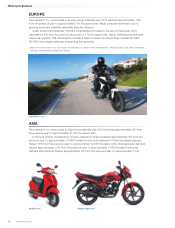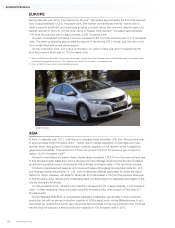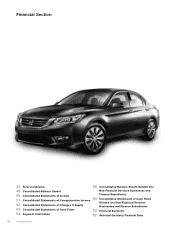Honda 2013 Annual Report Download - page 26
Download and view the complete annual report
Please find page 26 of the 2013 Honda annual report below. You can navigate through the pages in the report by either clicking on the pages listed below, or by using the keyword search tool below to find specific information within the annual report.
Risks Relating to Honda’s Industry
1. Honda may be adversely affected by market conditions
Honda conducts its operations in Japan and throughout the world, including North America, Europe
and Asia. A sustained loss of consumer confidence in these markets, which may be caused by con-
tinued economic slowdown, recession, changes in consumer preferences, rising fuel prices, financial
crisis or other factors could trigger a decline in demand for automobiles, motorcycles and power
products that may adversely affect Honda’s results of operations.
2. Prices for products can be volatile
Prices for automobiles, motorcycles and power products in certain markets may experience sharp
changes over short periods of time. This volatility is caused by various factors, including fierce com-
petition, which is increasing, short-term fluctuations in demand caused by instability in underlying
economic conditions, changes in tariffs, import regulations and other taxes, shortages of certain
materials and parts, steep rise in material prices and sales incentives. There can be no assurance
that such price volatility will not continue for an extended period of time or that price volatility will not
occur in markets that to date have not experienced such volatility.
Overcapacity within the industry has increased and will likely continue to increase if the economic
downturn continues in Honda’s major markets, leading, potentially, to further increased price volatility.
Price volatility in any of Honda’s markets could adversely affect Honda’s results of operations.
Risks Relating to Honda’s Business Generally
Currency and Interest Rate Risks
1. Honda’s operations are subject to currency fluctuations
Honda has manufacturing operations throughout the world, including Japan, and exports products
and components to various countries.
Honda purchases materials and components and sells its products and components in foreign
currencies. Therefore, currency fluctuations may affect Honda’s pricing of products sold and materials
purchased. Accordingly, currency fluctuations have an effect on Honda’s results of operations and
financial condition, as well as Honda’s competitiveness, which will over time affect its results.
Since Honda exports many products and components, particularly from Japan, and generates a
substantial portion of its revenues in currencies other than the Japanese yen, Honda’s results of
operations would be adversely affected by an appreciation of the Japanese yen against other
currencies, in particular the U.S. dollar.
Risk Factors
Annual Report 201324
























